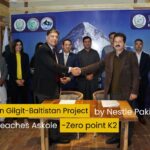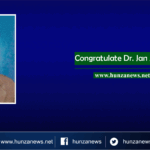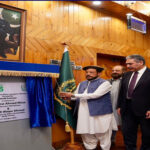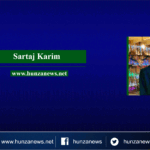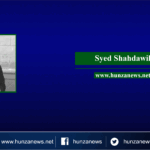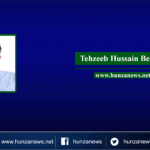In early times Hunza was ruled by monarch and it was the most loyal vassal to the Maharaja of Jammu and Kashmir. The monarch system in this region was finally dissolved by Zulfikar Ali Bhutto in 1974. The state bordered the Gilgit Agency to the south, the former princely state of Nagar to the east. Its capital was Baltit, now named as Karim abad, and its old settlement is Ganish Village. Hunza remained princely state for more than 900 years. The british many times attacked hunza and initially failed to conquer it. Finally in between 1889 and 1892 gained control of Hunza and neighbouring valley of Nagar. followed by
Formerly both the states Hunza and Nagar were one, ruled by the ruling family of Gilgit, the Mayroo Khan, apparently the first Muslim Rular of Nagar some 200 years after the introduction of the religion of Islam to Gilgit, married a daughter of Tra khan of Gilgit, who bore him twin sons named Moghlot and Girkis. From the former the present ruling family of Nager is descended. The twins are said to have shown hostility to one another from birth. Their father seeing this and unable to settle the question of succession, divided his state between them, giving to Girkis the north(Hunza), and to Moghlot the south(Nagar), bank of the river.
The traditional name for the ruler in Hunza was Thum, which is also used by people of both Hunza and Nagar as a respectful term for their rular. The wives of thum are styled ghenish,and their sons are called gushpoor.
In 2010, a landslide blocked the river and creating Attabad Lake, the potential collapse of which threatened the valley below.The Hunza is situated at an elevation of about 2,500 metres (8,200 ft). For many centuries, Hunza has provided the quickest access to Swat and Gandhara for a person travelling on foot. The route was impassable to baggage animals; only human porters could get through, and then only with permission from the locals.Hunza was easily defended as the paths were often less than 0.5 metres (20 in) wide. The high mountain paths often crossed bare cliff faces on logs wedged into cracks in the cliff, with stones balanced on top. They were also constantly exposed to regular damage from weather and falling rocks. These were the much feared “hanging passageways” of the early Chinese histories that terrified all, including several famous Chinese Buddhist monks such as Xuanzang.
Today, the famous Karakoram Highway crosses Hunza, connecting Pakistan to China via the Khunjerab Pass. Travelling up the valley from the south, Hunza is the land to the left, and the former state of Nagar to the right of the Hunza River. Regular bus and van services operate between Gilgit and Central Hunza (Ganish Village, Aliabad and Karimabad) and also between Gilgit and Sost Gojal. PTDC Office at Gilgit, arranges tours and transport for visitors.
Several high peaks rise above 6,000 metres (20,000 ft) in the surroundings of Hunza valley. The valley provides spectacular views of some of the most beautiful and magnificent mountains of the world which Ultar Sar 7,388 metres (24,239 ft), Bojahagur Duanasir II 7,329 metres (24,045 ft), Ghenta Sar 7,090 metres (23,261 ft), Hunza Peak 6,270 metres (20,571 ft), Darmyani Peak 6,090 metres (19,980 ft), and Bublimating (Ladyfinger Peak) 6,000 metres (19,685 ft). Hunza Valley is also host to the ancient watch towers in Ganish , Baltit Fort and Altit Fort. Watch towers are located in heart of Ganish Village, Baltit Fort stands on top of Karimabad whereas Altit Fortlies at the bottom.
As much as the valley is famous for its beauty, the people of Hunza are noted for their friendliness and hospitality. The locallanguages spoken are Burushaski, Wakhi and Shina, many people understand Urdu. The literacy rate of the Hunza valley is believed to be more than 90%. Virtually every child of the new generation studies up to at least high school level. Many pursue higher studies from prestigious colleges and Universities of Pakistan and abroad.Most of the people of Hunza are Ismaili Shia Muslims, followers of His Highness Prince Karim Aga Khan IV, while in Ganish Village more than 90% are Shia Muslims.
The Hunza region is home to people of three ethnicities:
The Lower Hunza area – (from Khizerabad to Nasirabad is mainly inhabited by the Shinakipeople who are Shina speakers;
- The Central Hunza area – (from Murtazaabad to Atta abad) is mainly inhabited by Burushaski speakers.
- The Upper Hunza area, known as Gojal – (from Shiskat to Khunjerab is mainly populated by Wakhi speakers;
Hunza-Nagar became a new district in Gilgit-Baltistan starting in July, 2009. There is planned to be a Northern Areas Legislative CouncilAssembly (NALA) seat for Hunza.
LOWER HUNZA (SHINAKI)
Lower Hunza is a sub region of Hunza, boundaries with Nagar valley on east and on south. The beautiful sub region of Hunza starts from a village Khizir abad and ends at Nasir Abad, Lower Hunza possess Khizir abad, Mayoon, Hussainabad, Khana Abad and Nasirabad. Nasirabad locates at KKH and makes it as a centre village of Lower Hunza.
The People of this region are mainly migrants from Central Hunza and speaks shina language, and many families belong to families of centre Hunza. The shina language is dominated language in this region that’s why people declare it as “Shinaki”.
Educationally Lower Hunza is sound enough and comparable to the other regions of Hunza, well educated personalities are possessed by this region. The private and governmental institutions are working in the region. The chain of Aga Khan Diamond jubilee schools and many other NGOs are serving their services for the educational development of this area. Personnel from this area are actively contributing in both government and private sector.
Culturally it is not much different from other regions of Hunza, it comes from their religious activites, from their birth and their marriage ceremonies.
Like other regions of Hunza, the main occasion celebrations are Novroz, Ginani, and Salgirahs, on these occasions delicious food traditional touch manufacture in the region, especially Sharbat and Harisa.
The region is famous for mulberry and high quality graphs, beyond these apricots, plums and cherry are other fruits. People grow maize, wheat, peas and vegetables.
KKH enter into the region on the first bridge of Hunza, at Nasirabad (Hindi) from Nagar Valley.
CENTER HUNZA
Center Hunza remained the administrative region during monarchial rule of Ayashoo dynast, a ruling family of Hunza for 980 years from 996-1974 and in realistic way center Hunza is capital center of Hunza State. Historically scholars published many credentials about the origin of families in center Hunza but no mutual consent literature confine the rationality about the origin of families in the Center Hunza.
Center Hunza starts from a beautiful village Murtaza abad and ends at Attaabad, central Hunza composed of villages namely Murtaza abad, Hassan abad, Ali abad, Dorkhan, Shiras, Garelth, Hyder abad, Ganish, Karim Abad (Baltit), Momin Abad, Altit, Ahmed Abad, Gama Sareth and Atta abad.
This is most populous sub region of Hunza; Center Hunza is two linguistic oriented region 97% people speak Burushaski and rest of 3% speaks Domki. The Buroshoo Hunzai families everywhere on the globe oriented from this region, the diversify families roots found in Baltit, Altit and Ganish. The main families of Baltit are Diramiting, Khurokutz, Barataling, and Boroung, the main families of Altit are Hussenkutz, Hakalkutz, Khunukutz and Shu-shuroting, and the main families of Ganish are Shuknoting, Chaboekutz, Barchating and Chil Ganishkutz. The 3% Domki families settled in Momin abad, and found in minor ratio in some villages of Hunza.
The culture of center Hunza is enriched with its uniqueness and well developed publicity throughout the globe. Traditional food, dance, music, folk stories, and events basically originated from this region and introduced by migrants in other parts of Hunza.
In traditional food Barowa Giyaling, Hamamo Giyaling, Gora Giyaling, Sharbat, Harisa, Mol, Chamus, Gashowa Cheel, Chapshoro, Diram fitti, Shoro, Khamolot, Harri Shapik, Gora Shapik, Buros Shapik, Tomoro-wa-Daodo, Barikutz, and Diltar
Beyond traditional food, the dance is very unique practices on traditional events and also on the blissful moments of the people. The instruments uses in the music are famous in the region. In previous times Domki speakers entertain people as a master of arts, today as art many youth are engaged with the art of musicology.
Occasion celebrates in center Hunza are Thomoshaling, Novroz, Ela Khudae, Ginani, Hoya, Shukoro Horotas, Salgirahs, Eids, Moharram and religious Majalis. The different feasts produce on nature of occasion in the region.
In crops the region is enriched with Wheat, Maize, Barley, Black Peas, Peas, Potatoes and Baroo. In fruits the region is famed with grapes, apples, apricots, peach and cherries.
The famous sites for tourist interest are Altit Fort, Baltit Fort, Ulter Glacier, Ulter peaks, Lady Finger Mountain, Ganish Mosque, Doikar. Along with the scenery of Hunza is famous in the world, river Hunza and the snow covered mountains makes it more charming and attractive.
For the respite of the tourist the town is properly managed and the main hotels are located in this region, infrastructure is highly appreciated able.
Upper Hunza (Gojal)
On the edge of Northern part of Islamic Republic of Pakistan, in Gilgit Baltistan Agency, a valley of beautiful villages Upper Hunza (Gojal) is situated. This is a sub region of famous region of Gilgit Baltistan Hunza, former princely state, valuable in international arena for peace, gorgeous landscape, mountains, simplicity, and education. The main corridors open to former USSR and now Rassia, and a great friend of Pakistan China from Upper Hunza (Gojal). Kunjareb pass, Chupurson pass, kilik, Mintaka and Shishaal passes are international passes open to both neighboring states of Pakistan (China and Rassia). The upper Hunza (Gojal) strategically important area due to border passes. Pakistani armed forces deployed on these passes for security measures.
Upper Hunza (Giojal) is beautiful valley of Hunza, and one of its sub region where two different linguistically people are existing, Burushaski speakers originated from central Hunza and migrated during kingdom of Ayashoo and wakhi speakers oriented from Wakhan corridor. 65% of population encompass of wakhi speakers and rest of 35% composed of Burushaski speakers.
The upper Hunza starts from Ayean Abad village, nowadays affected with natural hit (Atta Abad Disaster) and sunk completely in artificial lake; Upper Hunza extends to Misgar, Shimshaal and Chuporson, (Border areas). Gulmit village is capital city of upper Hunza, and Sost is important village for commercial purposes due to Sost dry port. Upper Hunza is sub divided into four regions, as Gojal1, 2, 3, 4 respectively. Gojal one composed of Ayean Abad, Shishkat, Gulmit, Passu, Hussaini. Gojal two composed of Khyber, Galapan, Gircha, Nazimabad, Hussain Abad, Sost, Khudabad and Misgar. Gojal 3 composed of Shimshaal and finally Gojal 4 composed of Khair Abad, Rashit, Kirming, Kill, Espangi, Shersaabz, and Zodokhon.
In religious aspect Upper Hunza serene of Ismailia Muslims, the culture erupts from tradition (Social norms and values) and as well as from religion. The unique culture of Upper Hunza composed of occasional events annually like Nowroz (starting of New Year), Bofaw (starting of irrigation year), Kitidit (starting water channels opening), Ginani (a festival on crops cutting), salgirahs (11th July, 23rd October, and 13th December). Traditionally marriages are interfamily marriages, in same faction and in same oriented families. On occasion of bereavement the all activities carry out on village based and as well as on family based. Entire societies of villages are bond with high and reputable social customs. Traditional foods are very important of nature derived from pure butter, milk, and meat especially, named as Molida, Mol, Diram fitti, Harisa, Sharbaat, Giyaling, and Shoroo. On traditional occasion tasty foodstuff is one of its unique cultural descriptive components.
In education this sub valley of Hunza parallel booms with other regions of Hunza with approximately 90% literacy rate. The famous schools of AKDN are operational in the area for a long time in all villages of the upper Hunza, along this private schools are operational too and government schools also exist in the region.
The employed citizens of this area are engaged in Government, semi Government and private organizations on leading positions. Some of people belongs to business community mostly trade with China and in western world, a good figure of population settled down in foreign countries for job, education and business. Agricultural people are also found in the area, mostly cash crops they grown potatoes, maize, black peas, green peas, wheat and barley.
In its main areas, which attracts tourists are Borith Lake, Attabad Lake, Khunjareb pass roof of the world, KKH wonder of the world, Batura glacier, Sost Dry port, and religious areas as Astans, Shah Shams Shimshaal, Bab Gundi Chupurson, and Shah Talib in Hussaini.
In sports youth engage with healthy activities, Cricket, Volleyball, Athletics are famous and traditional games like Hunting, Mindak, Gulli danda, and Daga Dagash.
In animals domestic and wildlife found in the area, in domestic Yolk, cow, Bulls, sheep, and goats are very famous, and in wild life Snow leopard, Marco polo sheep, and Snow sheep.
The main roads are Karakorum High way, Chuporson Road, Misgar road and Shimshaal road.


